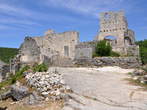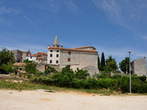Dvigrad is an abandoned settlement spread over two hills in Limska Draga, not far from Kanfanar. The ruins of a major medieval city are trying to be conserved and protected from further decay. The location of the ruins in relation to the road and the nearby Lim Bay testify to the fact that it once controlled an old trade route.
Here, in a small area, there are the remains of two forts and some interesting churches. In the early Middle Ages, the towns on these hills were called Moncastello and Parentino. The Illyrians already lived on the hills. The left town, Parentino, fell into disrepair already in the early Middle Ages. In the late Middle Ages, the town on the right hill, called Duecastelli, was owned by the patriarch of Ogle and later by the Venetians. Dvigrad is special for something else: it was abandoned in 1631 due to a plague epidemic. Residents who survived settled in nearby Kanfanar. For this reason, Dvigrad has preserved the unique image of the medieval urban design without subsequent constructions. In the abandoned city, defensive walls with towers and the entrance to the city can be distinguished, as well as the outlines of the foundations of around two hundred buildings. In the middle are the ruins of the church of St. Sophia, which was built in the 11th and 12th centuries on the site of an even older sacral building.
The pulpit from the 13th century is located in the parish church in Kanfanar. On it is a statue of Saint Sophia holding two cities in her hands. The parsonage, the guard house by the main entrance, the cistern, and the directions of the streets have also been preserved. There are rich archaeological sites in the vicinity of Dvigrad.












